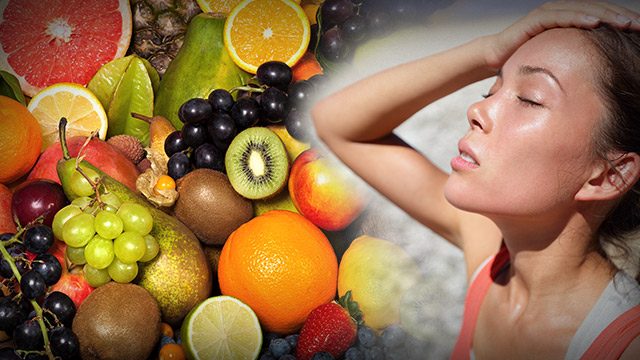SUMMARY
This is AI generated summarization, which may have errors. For context, always refer to the full article.

MANILA, Philippines – The summer season is all about getting outdoors with friends and family, but if there’s one thing that can spoil the fun it’s the unbearable heat.
Lately, the heat has become increasingly intense in the Philippines.
The temperature from April to May 2014 hovered between 35 to 37 degrees Celsius. Meanwhile, May 21 to 22 were identified as the “hottest days” of the same year as the registered temperature went past 37 degrees Celsius.
Being exposed to the sun and heat for long periods of time can lead to many health risks. Among these risks are dehydration, heat exhaustion, and heat stroke.
There are existing remedies to address these “summer ills” but just like other diseases, prevention is always better than cure. (READ: Summer maladies, first aid remedies)
Culture of eating fruits
Aside from not staying under the sun for long periods and always making sure to keep hydrated, you can also eat a lot of fruits.
But eating fruits seems to be rather uncommon in the country, going by the latest Food Consumption Survey (FCS) of the Food and Nutrition Research Institute (FNRI).
According to the results, only two fruits made it to the 20 frequently consumed foods by Filipino households: tomatoes on the 17th spot and bananas on the 20th. (READ: What are the top 20 food products consumed by Filipinos?)
This is alarming as a person can get a lot of needed nutrients from fruits, especially during the summer season.
Nature’s sweets can replenish the electrolytes and fluids lost by simply sweating and being exposed to the sun. When consumed properly, fruits will contribute to keeping you healthy during the summer.
Watermelons, pineapples, cucumbers, apples, pears, tomatoes, and oranges are just some fruits with a high water content. If you are planning on staying out in the sun and do exhausting activities, it’s best to have these within reach for quick rehydration, when water isn’t available.
Mangoes, guavas, papayas, and other citrus fruits are rich sources of vitamin C and very helpful in strengthening body resistance against infection. Meanwhile, yellow fruits such as bananas and pineapples are rich in beta-carotene.
Making the most out of fruits
To make the most out of their benefits, it is important that one gets the best fruits. When the freshness of a fruit is maintained, the nutrients and vital components remain intact.
But how can one make sure that fruits available in the market are safe or in the freshest state? These tips provided by the Food and Drug Authority (FDA) can help you choose wisely:
- Make sure to check that the fruits are firm and not bruised or damaged.
A bruise on a fruit is a sign of cellular damage. Despite no hard evidence that this is bad for a person, a damaged fruit is more vulnerable to varieties of food-borne molds.
Apples, bananas, oranges, and papayas are best consumed when they are firm and well-colored. Soft or lightweight ones are said to less likely yield juices which contain essential nutrients.
- Be extra careful when buying pre-cut fruits from the grocery store
Only buy pre-cut items, such as watermelons and pineapples, if they are refrigerated or, at the least, surrounded by ice.
Exposed fruits are more vulnerable to contamination which may led to diseases such as diarrhea.
- Be wary of the type of storage of each kind of fruit
Not all fruits need to be stored inside a refrigerator as doing so may even cause damage. Meanwhile, storing at room temperature may lengthen their shelf life.
Apples, grapes, and oranges can be refrigerated with a temperature of 4 degrees Celsius and below to prolong freshness while bananas and papayas are best stored at room temperature.
If taking home pre-peeled and pre-cut fruits, it is best to refrigerate them immediately.
Maintain a balanced diet
Eating fruits however is not enough. No matter how healthy fresh fruits can be, it is still best to maintain a healthy and balanced diet.
According to the Nutritional Guidelines for Filipinos of FNRI, nutrients needed by the body cannot be obtained just by eating one single food so it’s best to mix and match – just make sure they’re healthy.
To achieve this, the institute suggests Filipinos follow Pinggang Pinoy, a daily meal guide promoting healthy eating habits. This way, they can be aware of the right servings needed to eat each meal. (READ: What a Pinggang Pinoy should look like)
Taking care of one’s nutrition can result in many benefits to the mind and body. And staying healthy is important so you won’t miss those summer gatherings with friends and family. – Rappler.com
How are you battling the summer heat? Tell us in the comments section below!
Add a comment
How does this make you feel?
There are no comments yet. Add your comment to start the conversation.